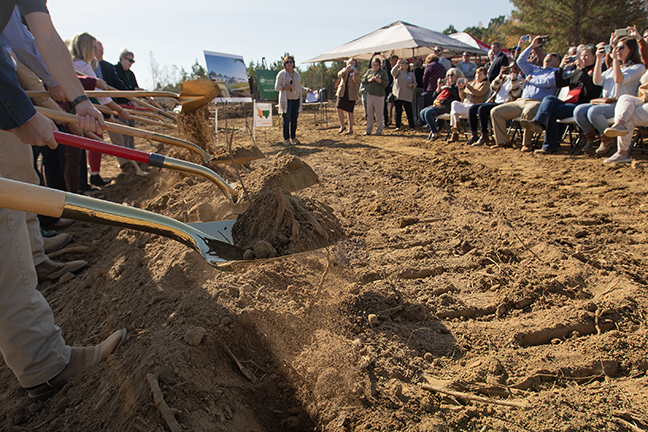Welcome!

Shovels break soil during a groundbreaking ceremony for the Farm, Food, And Family Education Center just off US 64, near the Asheboro Mall, on Nov. 13. Eric Abernathy/Randolph Hub
Ag Center takes root two decades after conception
ASHEBORO — Groundbreaking for the Randolph County Farm, Food and Family Education Center took place on Nov. 13, 21 years after it was first envisioned.
The 104-acre site is located on East Dixie Drive in Asheboro just across from the intersection with Salisbury Street.
A large crowd gathered for ceremonies that were emceed by Mary Lisk, co-chair of the Asheboro/Randolph Chamber of Commerce. She introduced David Allen, vice chair of the Randolph County Board of Commissioners, to give a timeline of the project.
“It’s been a long time coming,” Allen said, noting that the county’s Voluntary Agriculture District board members were the first to recognize the need for a place where the agriculture community could meet. At that time, there was not enough funding for such a project and no place to put it.
Allen said that in 2014 he and others visited several agriculture centers in other counties and states. “We wanted to see the process and what we could do.” During that period, he said, the Randolph County Tourism Development Authority became involved, considering such a facility as being a tourist draw.
In December 2016, he said, the current property became available and the county was able to purchase it from Klaussner Furniture Industries after selling another property. Then, with a place to put an ag center, the question was how much would it cost.
“The original proposal was for an arena, a civic center, a hotel,” Allen said. But cost estimates provided in 2018 put the project on the back burner. “It wasn’t the right time,” Allen said.
The commissioners then considered doing such a large project in phases. “Site preparation was the big cost,” he said.
Then in 2021, NC Rep. Allen McNeill called to say that there was money available from federal COVID funds, as much as $25 million for such a project. But the county needed to provide an updated document about the proposed ag center.
The Cooperative Extension Randolph Center produced a 27-page report within 24 hours.
McNeill and NC Rep. Pat Hurley along with NC Sen. Dave Craven were able to get the money into the state budget and “things began rolling,” according to Allen. Additional funds, including interest-free USDA loans through the Randolph Electric Membership Corporation, a grant from the NC Tobacco Trust Fund and other sources brought the project to the present. HH Architects designed the Farm, Food and Family Education Center and bids for construction were awarded.
McNeill told the gathering, “I was fortunate there was money floating around. In 2021 we cobbled together the $35 million needed. I wasn’t sure the day would ever come until I could see dirt moving. Dave Craven and Pat Hurley worked with me to see this happen.”
Asheboro Mayor David Smith called the groundbreaking “a glorious day in Asheboro. We’re pleased to be a part of this.”
Smith said the city already had plans to extend water and sewer lines down US 64 east and “agreed in the beginning to provide utilities to this site. Congratulations to the county for persevering. It’s been a dream for years.”
Kenny Sherin, director of the Cooperative Extension Randolph Center, made note of “so many people involved.” That includes the local school systems and a strong 4-H program.
“We need this here, demonstration spaces. It’s about time we got an ag center,” Sherin said.
Other speakers included representatives from NC A&T State University, NC State University and the NC Tobacco Trust Fund.
Dale Lambert, CEO of Randolph Electric Membership Corporation, said that 85 years ago a group met not too far from the future ag center to talk about getting electricity into rural areas. “Electricity has transformed agriculture in Randolph County,” he said. “The ag community started the co-op. We’re glad to be a partner in this, which will be a catalyst for the future.”
Farm, Food and Family Education Center by the numbers
•The building to house Cooperative Extension and Soil & Water offices will be 28,138 square feet.
•The arena will be 18,110 square feet with an animal staging area and ample trailer parking..
•The exhibit hall will be 9,254 square feet with seating for up to 540 people.
•An educational greenhouse will be 28-by-40 feet with a cool cell.
•There will be an educational orchard.
•A demonstration garden will cover about one acre.
•There will be a food hub of approximately 3,300 square feet.
•Two commercial kitchens will cover approximately 2,752 square feet.
•A future county agricultural fair will be on 3.4 acres.
•There is the potential for a future walking nature trail.
•A courtyard of 3,198 square feet will offer personalized bricks.
•There will be greenspace for the 4-H youth programs.
•Pasture land will be available for livestock demonstrations.
•There will be field crop test plot areas.
